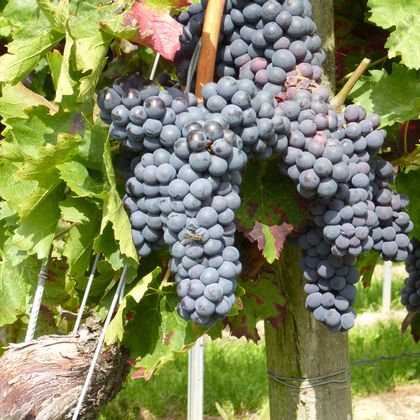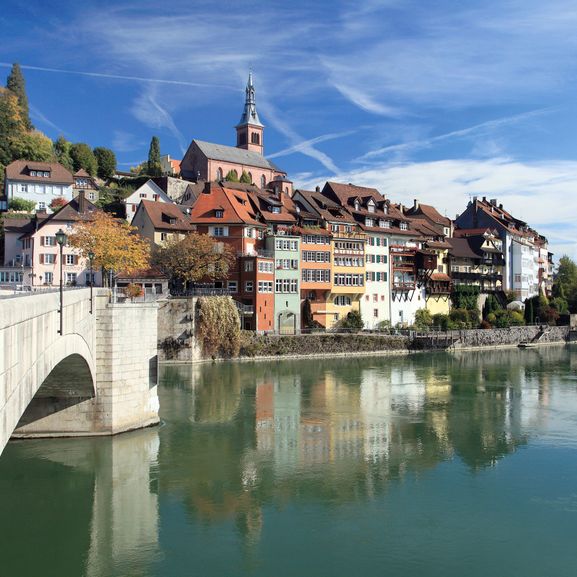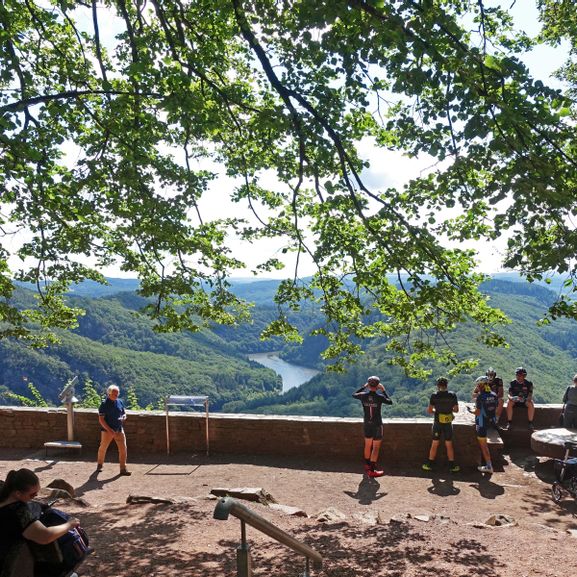Palatinate: Germanys sunny side
Cycling trips in the palatine region
Look forward to this multi-faceted holiday region with 5451 km² and 1.4 million inhabitants. The lovely Palatinate is bordered to the west by the Saarland, on the northwest by the Hunsrück, in the east it is bordered by the Rhine and in the south the French Alsace boarders. Through the middle of the Palatinate, the 85 km long German Wine Route runs with its picturesque vineyard landscape and many small winding wine villages. The Palatinate benefits from the mild climate, so that here exotic plants such as figs, lemons, kiwis and famous Palatinate chestnuts grow. The adjacent Palatinate Forest Nature Park offers together with the Northern Vosges Biospere Reserve more than 12.000 km of hiking trails, defiant castles and strange rock formations. The Rhine valley finally provides Altrheinarme with a particularly rich flora and fauna and vast fertile fields where asparagus, strawberries and tobacco are growing.
Our cycling trips in the palatine region
This is how beautiful it is in the palatine region
Joyful cycling in the Palatinate
Well-signposted cycle routes with well-maintained cycle paths and varying degrees of difficulty criss-cross the Palatinate and make it a real pleasure to cycle from village to village and from vineyard to forest in an almost Mediterranean climate.
Därkem, Fränsem, Landaach, Neischdadt
Here everything revolves around wine. In Bad Dürkheim, Pfälzisch Därkem, Dergem or Derkem, visit the Dürkheim Giant Barrel, incidentally the largest barrel in the world, and climb up to the ruins of Hardenburg Castle, from where you can enjoy sweeping views. Freinsheim, Pfälzisch Fränsem, is enclosed by a medieval city wall and its pretty, baroque old town has been superbly restored. Landau, Landaach, has an almost southern feel. You stroll through the historic alleys and to the market, drink a cappuccino here and a glass of champagne there. Finally, it's all about wine in Neustadt an der Weinstraße, Neischdadt an de Woischdrooß, the wine capital of the Palatinate. But hike up to Hambach Castle, a site of German history and the cradle of democracy, where the black-red-gold flag was raised for the first time in 1832, stroll through the alleys and settle down to try a sip or two.
Numerous Wine Festivals and Kerwen
As far as culture, festivals and celebrations are concerned, the theme is, no surprise, wine: the Weinbergnacht in Bad Dürkheim is the largest open-air wine tasting in the Palatinate, the Wurstmarkt is also a wine festival, and the largest in the world. In Neustadt, the Weinlesefest (wine harvest festival) takes place in September, in Landau the Federweißen Fest (feather white festival) in October,
and the Weinstraßen-Tag (wine street day) at the end of August. Drink a wine spritzer, a Riesling or Burgundy from a so-called Dubbeglas and listen to live music. The festivals in the romantic wine villages are numerous, often there is also a Kerwe (high German Kirchweih or Kirmes).
Asgschebbde and Hooriche, Keschde and Saumagen
The typical Palatinate dish doesn't really exist, because the different regions have their own different specialties. Try pastries like hooriche (hairy potato dumplings) or asgschebbde (water sparrows) in the west or north, fish along the Rhine, game from the Bienwald forest and locally grown vegetables to go with it, and keschde (chestnuts or sweet chestnuts) in the fall. In addition to Fläschknepp (meat dumplings), the menu often includes the well-known Saumagen, which is filled with lean pork, sausage meat, potatoes and possibly onions as a casing. There are numerous variations of it. Sauerkraut is often served as a side dish in the Palatinate. People like to drink Pfälzer Woi, wine, with it.
Forest and exoticism
The Palatinate in southwestern Germany is a region spoiled by a mild climate with diverse and varied landscapes: The Rhine plain with its oxbow lakes, rich fauna and flora and fertile fields where strawberries, asparagus and tobacco thrive, the Palatinate Mountains, the Palatinate Forest Biosphere Reserve with the largest contiguous forest area in Germany and, in the middle of it all, the German Wine Route. Vines thrive here in the Palatinate sunshine particularly splendidly, as do exotic almond trees, oleander, lemons or figs.



